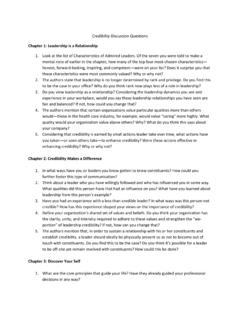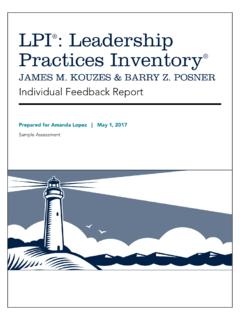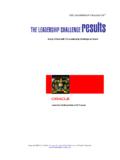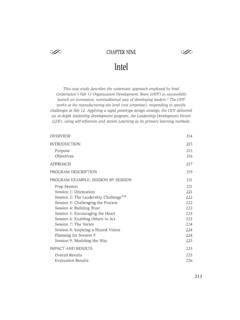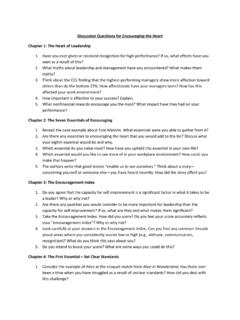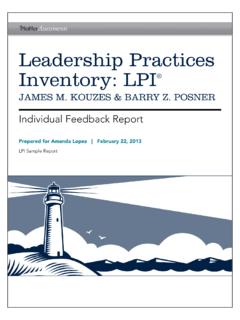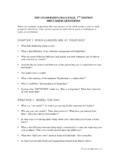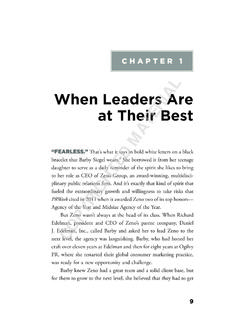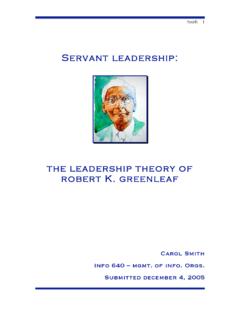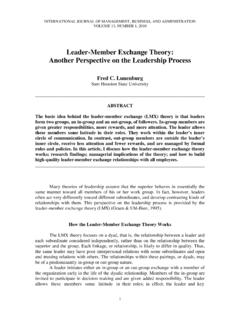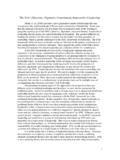Transcription of May 12, 2002 THE LEADERSHIP PRACTICES INVENTORY: …
1 Appendix0512BP. Page 1. May 12, 2002. THE LEADERSHIP PRACTICES inventory : theory AND EVIDENCE BEHIND THE. FIVE PRACTICES OF EXEMPLARY LEADERS. There is considerable empirical support for the Five PRACTICES of Exemplary LEADERSHIP framework. Here we provide an overview of the development and validation of the LEADERSHIP PRACTICES inventory (LPI). Comparisons of LPI scores along a number of critical dimensions are summarized, as well as brief insights into findings by other researchers utilizing this LEADERSHIP framework and instrument. Readers and scholars interested in more academic discussions of the LPI can find several more technical reports1 as well as other research descriptions on our website ( ).
2 INSTRUMENT DEVELOPMENT AND PROCEDURE. The LEADERSHIP PRACTICES inventory was developed through a triangulation of qualitative and quantitative research methods and studies. In-depth interviews and written case studies from personal-best LEADERSHIP experiences generated the conceptual framework, which consists of five LEADERSHIP PRACTICES : Modeling the Way Inspiring a Shared Vision Challenging the Process Appendix0512BP. Page 2. Enabling Others to Act Encouraging the Heart. The actions that make up these PRACTICES were translated into behavioral statements. Following several iterative psychometric processes, the resulting instrument has been administered to over 350,000 managers and non-managers across a variety of organizations, disciplines, and demographic backgrounds.
3 A version of the LPI has also been developed for specific use with high school and college Validation studies that we, as well as other researchers, have conducted over a fifteen-year period consistently confirm the reliability and validity of the LEADERSHIP PRACTICES inventory and the Five PRACTICES of Exemplary Leaders model. Overall, the LPI, has been extensively applied in many organizational settings and is highly regarded in both the academic and practitioner world. 3. The conceptual portion of the Five PRACTICES of Exemplary Leaders framework grew out of the collection and analysis of case studies of personal-best LEADERSHIP experiences.
4 The Personal-Best LEADERSHIP Experience questionnaire is twelve pages long and consists of thirty-eight open-ended questions, such as these: Who initiated the project? What made you believe you could accomplish the results you sought? What special, if any, techniques or strategies did you use to get other people involved in the project? Did you do anything to mark the completion of the project, at the end or along the way? What did you learn most from this experience? What key lessons would you share with another person about LEADERSHIP from this experience? Completing the Personal-Best questionnaire generally requires about an hour of reflection and expression.
5 We've collected more than 4,000 of these surveys and over 7,500 additional respondents have completed a short form of this survey. In addition to the case studies, in-depth interviews have been conducted across from managers and individual contributors across a wide variety of public and private-sector companies Appendix0512BP. Page 3. around the world. These interviews have generally taken forty-five to sixty minutes; in some cases, they have lasted four to five hours. The total number of interviews now numbers well over 500 respondents. The experience (and the process) has been relatively consistent over the nearly two decades that we have been collecting case studies.
6 The LPI was created by developing a set of statements describing each of the various LEADERSHIP actions and behaviors. Each statement was originally cast on a five- point Likert scale, and reformulated in 1999 into a more robust and sensitive ten-point Likert-scale. A higher value represents more frequent use of a LEADERSHIP behavior. For example: (1) Almost never do what is described in the statement; (2) Rarely; (3) Seldom;. (4) Once in a while: (5) Occasionally; (6) Sometimes; (7) Fairly Often; (8) Usually; (9). Very Frequently; and, (10) Almost always do what is described in the statement. Statements were modified, discarded, or included following lengthy discussions and iterative feedback sessions with respondents and subject matter experts as well as empirical analyses of various sets of behaviorally based statements.
7 Ongoing analysis and refinements in the instrument continue, with a database involving well over 100,000. respondents. The LPI contains thirty statements six statements for measuring each of the five key PRACTICES of exemplary leaders. Both a Self and Observer form of the LPI have been developed. In addition, subsequent forms of the LEADERSHIP PRACTICES inventory have been developed for use with various populations. For example, there is a version for use with individual contributors or non-managers (LPI-Individual Contributor), another for use with a group of people (LPI-TEAM), and one for use with college students (LPI- Student). These instruments have both a Self and Observer version, and all have been subject to the same psychometric analyses as were applied originally to the Participating individuals first complete the LPI-Self and subsequently request five-to-ten Appendix0512BP.
8 Page 4. people familiar with their behavior to complete the LPI-Observer. The LPI-Observer is voluntary and generally anonymous (respondents can indicate their relationship to the leader; as in, this individual is my manager, co-worker or peer, direct report, or other). Typically, the instruments are returned directly to the researchers or seminar facilitator. The LPI (self and observer forms) takes approximately eight to ten minutes to complete, and is capable of being either hand or computer scored. PSYCHOMETRIC PROPERTIES OF THE LPI. Means and Standard Deviations Means and standard deviations for each LPI scale for leaders (self) and their constituents ( , all observers, managers, direct reports, coworker or peers, and others) are presented in Table Based upon mean scores, Enabling is the LEADERSHIP practice most frequently reported being used.
9 This is closed followed by Modeling; with the average scores for Challenging and Encouraging being fairly similar. Inspiring is perceived (both by respondents and their constituents) as the LEADERSHIP practice least frequently engaged in. Appendix0512BP. Page 5. Table 1. LPI Means and Standard Deviations by Respondent Category LEADERSHIP Respondent Category Practice Leaders Observers Manager Direct Co-Worker Others (Self) (All) Report or Peer ---------------------------------------- ---------------------------------------- --------------------------- Model Mean Std Deviation Inspire Mean Std Deviation Challenge Mean Std Deviation Enable Mean Std Deviation Encourage Mean Std Deviation ---------------------------------------- ---------------------------------------- --------------------- Internal Reliability Reliability refers to the extent to which an instrument contains measurement errors that cause scores to differ for reasons unrelated to the individual respondent.
10 The fewer errors contained, the more reliable the instrument, and instrument reliabilities above .60 are considered The reliabilities for the LPI are consistently above this criteria (see Appendix0512BP. Page 6. Table 2). There is a tendency for the reliability coefficients from the LPI-Self (between .75 and .87) to be somewhat lower than those for the LPI-Observer (ranging between .88. and .92); however, this is not problematic. Table 2. Reliability (Cronbach Alpha) Coefficients for the LPI. by Respondent Category LEADERSHIP Respondent Category Practice Leader Observers Manager Direct Co-Worker Others (Self) (All) Report or Peer ---------------------------------------- ---------------------------------------- ------------------- Model.
